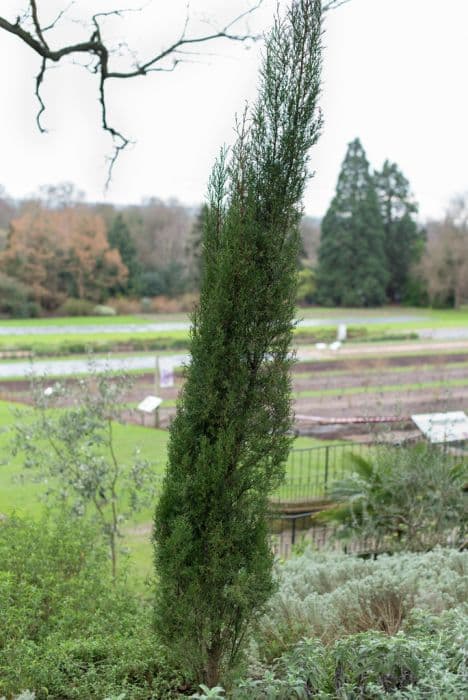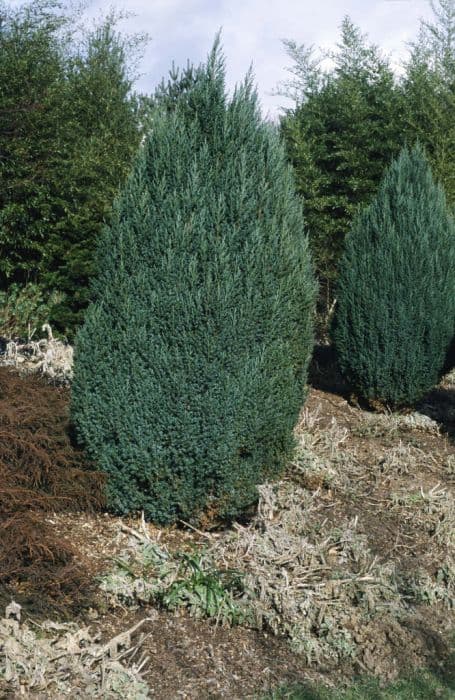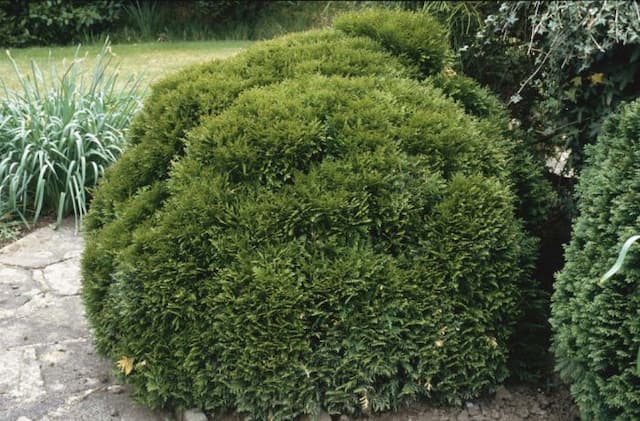Blue Arrow Juniper Juniperus scopulorum 'Blue Arrow'











ABOUT
The 'Blue Arrow' juniper is a visually striking plant known for its dense, columnar form. Its foliage is comprised of tightly-packed, thin needle-like leaves that have a rich, silvery-blue hue which maintains its vibrancy throughout all seasons. The texture of the foliage is fine to medium, and it creates a smooth, almost soft appearance from a distance, but remains slightly prickly to the touch. This juniper's upright growth habit allows it to provide a strong vertical accent in the landscape, making it an ideal choice for creating hedges or privacy screens without occupying too much horizontal space. The 'Blue Arrow' develops small, berry-like seed cones, which may have a bluish or silvery appearance and can add subtle interest upon closer inspection. Overall, it is admired for its narrow form and the brilliant blue-green shades of its foliage, which can provide a lovely contrast to the greens of other plants or to the built environment.
About this plant
 Names
NamesFamily
Cupressaceae.
Synonyms
Blue Arrow Juniper, Rocky Mountain Juniper, Colorado Red Cedar.
Common names
Juniperus scopulorum 'Blue Arrow'.
 Toxicity
ToxicityTo humans
The plant known as Rocky Mountain juniper generally has low toxicity to humans. However, consuming parts of this plant can cause mild stomach upset if ingested, so it's advised to avoid doing so. There are no severe toxic effects commonly associated with this plant for humans.
To pets
For pets, the Rocky Mountain juniper may cause mild gastrointestinal upset if ingested, reflected in symptoms such as vomiting or diarrhea. This is similar to the potential reaction in humans, and while it is not considered highly toxic, it is best to prevent pets from consuming parts of the plant to avoid these unpleasant effects.
 Characteristics
CharacteristicsLife cycle
Perennials
Foliage type
Evergreen
Color of leaves
Blue-green
Height
12-15 feet (3.6-4.5 meters)
Spread
2-3 feet (0.6-0.9 meters)
Plant type
Shrub
Hardiness zones
4-7
Native area
North America
Benefits
 General Benefits
General Benefits- Drought Tolerance: Once established, Blue Arrow juniper requires minimal watering and can thrive in dry conditions.
- Low Maintenance: It has minimal pruning and care requirements, making it an easy choice for many landscapes.
- Visual Appeal: This juniper offers a vertical, columnar growth habit and attractive blue-green foliage that provides year-round interest.
- Erosion Control: Its root system can help stabilize slopes and prevent soil erosion.
- Privacy Screen: Because of its tall and narrow growth, Blue Arrow juniper is often used in hedges or for privacy screens.
- Wildlife Habitat: Provides cover for birds and other wildlife, although it is not known for significant food offerings.
- Adaptability: It is adaptable to a range of soil types, as long as they are well-drained.
- Urban Tolerant: It withstands pollution and urban conditions better than many other trees.
- Cold Hardy: This plant is resistant to cold and can survive in low temperatures, making it suitable for many northern climates.
- Disease and Pest Resistance: It has a natural resistance to many common pests and diseases, reducing the need for chemical treatments.
 Medical Properties
Medical PropertiesThis plant is not used for medical purposes.
 Air-purifying Qualities
Air-purifying QualitiesThis plant is not specifically known for air purifying qualities.
 Other Uses
Other Uses- Juniper 'Blue Arrow' can be used as a natural barrier or privacy screen due to its dense foliage, growing in a narrow, upright fashion.
- The wood from 'Blue Arrow' can be used for small woodworking projects like making birdhouses or picture frames, as it is sturdy and has a pleasant grain.
- Its branches and foliage can be used in floral arrangements for their distinctive blue-green color and pleasant aroma.
- The tree can serve as a windbreak when planted in rows, protecting gardens or smaller structures from strong winds.
- Juniper 'Blue Arrow' is used in bonsai culture, where its natural form can be miniaturized and shaped for aesthetic purposes.
- The dense foliage can act as a noise barrier when planted alongside roads or between properties.
- Due to its resistance to deer browsing, 'Blue Arrow' can be used in landscaping in areas with high deer populations to minimize garden damage.
- It can be used as a habitat for birds, offering shelter and nesting sites within its branches.
- The aromatic foliage can be harvested and used to create natural potpourris or sachets, giving a fresh woodland scent to indoor spaces.
- 'Blue Arrow' junipers can be planted as part of a themed garden, such as a rock or xeriscape garden, due to their drought tolerance and texture.
Interesting Facts
 Feng Shui
Feng ShuiThe Rocky Mountain juniper is not used in Feng Shui practice.
 Zodiac Sign Compitability
Zodiac Sign CompitabilityThe Rocky Mountain juniper is not used in astrology practice.
 Plant Symbolism
Plant Symbolism- Protection: Junipers, in general, are often associated with protection due to their prickly foliage which is thought to guard against negative forces.
- Purity: The clean, sharp scent of the 'Blue Arrow' Juniper is seen as a symbol of cleanliness and purification, often used in rituals to cleanse and protect spaces.
- Health: Traditionally, Juniper plants have been used for their medicinal properties, symbolizing healing and the prevention of illness.
- Longevity: As evergreens, Juniper plants like the 'Blue Arrow' are symbols of eternal life and enduring through hardships given their ability to live for many years.
- Sanctuary: The robust nature of the Juniper tree provides a safe haven for wildlife, thus becoming a symbol of sanctuary and a safe dwelling place.
 Water
WaterThe Rocky Mountain Juniper 'Blue Arrow' prefers to be watered deeply and infrequently to mimic its natural environment. Aim to water the plant when the top 2-3 inches of soil are dry, which typically equates to once every week to two weeks, depending on climate conditions and soil drainage. Watering should be done at the soil level, avoiding wetting the foliage to prevent fungal diseases. As a guideline, provide about 1-2 gallons per watering session for young plants, and increase the amount as the plant grows larger, always monitoring soil moisture levels to avoid overwatering.
 Light
LightThe Rocky Mountain Juniper 'Blue Arrow' thrives in full sun conditions, ideally receiving at least 6 hours of direct sunlight daily. It will perform best in a spot that offers unfiltered, bright sun for the majority of the day. Avoid planting 'Blue Arrow' in heavily shaded areas, as insufficient sunlight can affect its growth and cause it to lose its characteristic tight, columnar form.
 Temperature
TemperatureThe Rocky Mountain Juniper 'Blue Arrow' is a hardy plant that can withstand a wide range of temperatures. It can survive in winter temperatures as low as -30°F and is quite heat tolerant, managing well in summer temperatures up to 100°F. The ideal temperature range for this juniper is between 40°F and 80°F, where it can grow most vigorously.
 Pruning
PruningThe Rocky Mountain Juniper 'Blue Arrow' usually requires minimal pruning due to its natural columnar shape. However, pruning may be necessary to remove dead or damaged branches and to maintain desired form or size. The best time to prune is in late winter or early spring before new growth begins. It is recommended to prune sparingly, as junipers do not readily regrow from old wood.
 Cleaning
CleaningAs needed
 Soil
SoilRocky Mountain Juniper thrives in well-draining soil with a pH range of 6.0 to 8.0. A mixture of loam, sand, and compost creates the best soil environment. Ensure ample organic matter for nutrient retention and aeration.
 Repotting
RepottingRocky Mountain Juniper is typically not repotted as it's grown outdoors; however, if grown in containers, repot every 3-4 years.
 Humidity & Misting
Humidity & MistingRocky Mountain Juniper prefers a low to moderate humidity level, typical of its native dry mountainous environments.
 Suitable locations
Suitable locationsIndoor
Position it near a sunny window and ensure good airflow.
Outdoor
Plant in full sun with well-draining soil; water sparingly.
Hardiness zone
3-7 USDA
 Life cycle
Life cycleJuniperus scopulorum 'Blue Arrow', commonly known as the Blue Arrow Juniper, begins its life as a seed, requiring a period of stratification to break dormancy. Upon germination, a seedling emerges, and roots establish within the soil while the shoot begins to grow upward. As a juvenile, the plant slowly matures over several years, developing its characteristic narrow, columnar form and vibrant, blue-green needle-like leaves. The Blue Arrow Juniper then enters its reproductive phase, producing tiny male and female cones on separate plants; successful pollination results in seed development. After many years, the Blue Arrow Juniper reaches its full maturity, often standing tall at over 10 to 15 feet with a lifespan that can exceed several decades. Over time, the mature plant may experience a decline in vigor, eventually leading to senescence and death, completing its life cycle.
 Propogation
PropogationPropogation time
Late winter to early spring
The Juniperus scopulorum 'Blue Arrow', commonly known as the Blue Arrow Juniper, is most successfully propagated through the method of semi-hardwood cuttings. This technique is typically performed during the late summer to early autumn months when new growth has matured but is not fully hardened. To propagate by semi-hardwood cuttings, a gardener would take cuttings about 4 to 6 inches long from the current year's growth, ensuring each cutting has several sets of needles. The base of the cuttings is then dipped in rooting hormone to encourage development and then planted in a well-draining soil mix. The soil should be kept moist but not waterlogged, and the cuttings should be placed in a location with indirect light and ideally provided with bottom heat. With proper care, roots usually develop within a few months, after which the new plants can be gradually acclimated to outdoor conditions before transplantation to their final location.









